 SYNOPSIS:
SYNOPSIS:
“Scientist Jan Benes, who knows the secret to keeping soldiers shrunken for an indefinite period, escapes from behind the Iron Curtain with the help of CIA agent Grant. While being transferred, their motorcade is attacked. Benes strikes his head, causing a blood clot to form in his brain. Grant is ordered to accompany a group of scientists as they are miniaturised. The crew has one hour to get in Benes’s brain, remove the clot and get out.” (courtesy IMDB)
REVIEW:
The sixties contribution to the ‘Shrinking Man’ genre was Fantastic Voyage (1966), which remains one of the most spectacular of the genre. In the near future, a medical team and their submarine are miniaturised and injected into the bloodstream of a dying scientist. They have sixty minutes in which to eliminate a blood clot and escape. As they travel through his body they encounter a fantastic foreign world of giant monsters and other dangers. To make matters worse, one of them is trying to sabotage the mission.
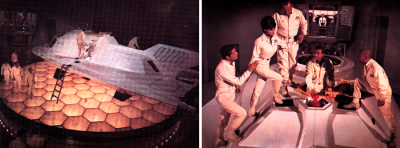 As usual with these films, the problem of mass is completely ignored: If it were possible to shrink five people and a submarine to the size of a human cell, the combined mass would be so concentrated that it would immediately fall through the floor and end-up in the centre of the Earth. In his novelisation, science fiction author Isaac Asimov did his best to rationalise some of the script’s most obvious scientific idiocies, but with little success. The screenplay was based on a short story by Otto Klement and Jay Lewis Bixby, and adapted by science fiction author David Duncan, who had already written a number of scripts including The Black Scorpion (1957), The Monster That Challenged The World (1957) and The Time Machine (1960). The film was directed by my old mate Richard Fleischer, who was kind enough to bring me on board as one of the film’s many advisers.
As usual with these films, the problem of mass is completely ignored: If it were possible to shrink five people and a submarine to the size of a human cell, the combined mass would be so concentrated that it would immediately fall through the floor and end-up in the centre of the Earth. In his novelisation, science fiction author Isaac Asimov did his best to rationalise some of the script’s most obvious scientific idiocies, but with little success. The screenplay was based on a short story by Otto Klement and Jay Lewis Bixby, and adapted by science fiction author David Duncan, who had already written a number of scripts including The Black Scorpion (1957), The Monster That Challenged The World (1957) and The Time Machine (1960). The film was directed by my old mate Richard Fleischer, who was kind enough to bring me on board as one of the film’s many advisers.
 Richard’s early films were taut film noir thrillers such as Bodyguard (1948), The Clay Pigeon (1949), Follow Me Quietly (1949), Armored Car Robbery (1950), and The Narrow Margin (1952). He was chosen by Walt Disney – his father’s former rival – to direct Twenty Thousand Leagues Under The Sea (1954). He became known for big features, often employing special effects, such as Barabbas (1961), Doctor Dolittle (1967), and Tora! Tora! Tora! (1970). He directed many action adventures such as Violent Saturday (1955), Bandido (1956), The Vikings (1958), Soylent Green (1973), Mister Majestyk (1974) and Conan The Destroyer (1984). He also directed a trilogy of films concerning famous serial killers: Compulsion (1959), The Boston Strangler (1968) and Ten Rillington Place (1971).
Richard’s early films were taut film noir thrillers such as Bodyguard (1948), The Clay Pigeon (1949), Follow Me Quietly (1949), Armored Car Robbery (1950), and The Narrow Margin (1952). He was chosen by Walt Disney – his father’s former rival – to direct Twenty Thousand Leagues Under The Sea (1954). He became known for big features, often employing special effects, such as Barabbas (1961), Doctor Dolittle (1967), and Tora! Tora! Tora! (1970). He directed many action adventures such as Violent Saturday (1955), Bandido (1956), The Vikings (1958), Soylent Green (1973), Mister Majestyk (1974) and Conan The Destroyer (1984). He also directed a trilogy of films concerning famous serial killers: Compulsion (1959), The Boston Strangler (1968) and Ten Rillington Place (1971).
 Richard said he was attracted to the project because it had a unique idea, something he had never seen before. He was fascinated by the whole idea of going on a trip through the human body and presenting it from such an unusual perspective. What also attracted him was the possibility of being able to inspire young people to some understanding of the incredible complexity of the human body, and the sheer wonder of it. He told me:
Richard said he was attracted to the project because it had a unique idea, something he had never seen before. He was fascinated by the whole idea of going on a trip through the human body and presenting it from such an unusual perspective. What also attracted him was the possibility of being able to inspire young people to some understanding of the incredible complexity of the human body, and the sheer wonder of it. He told me:
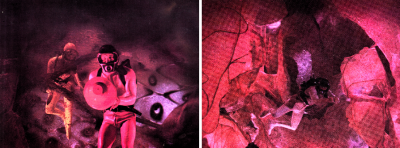 “It’s such a fantastic mechanism but we often take it for granted and don’t think of it as anything special, so I tried to get that across in the film. Of course, a lot of the sets representing various internal parts of the body were stylised but, even so, much of the film is completely accurate in the way things really look. For instance, our portrayal of the molecular structure of the body is astounding in its accuracy, it’s an amazingly abstract creation in itself so we didn’t have to stylise it. It was a very hard picture to make, and a very boring one to make. It was a very slow and laborious job because, for one thing, we had that big submarine to manipulate and shoot, and getting all those people wired-up and rehearsed for each shot. Then a wire would break and we’d have to start all over again. In a lot of shots we had to use blue backings for the traveling mattes and blue backings are always difficult to light. We’d hopefully get one set-up done in the morning and one in the afternoon and the rest of the time one just waited. The whole film took about a year to make – there were hundreds of days of actual shooting on it. But even so, I still love making big films – they’re a strain but then making any film is a strain.”
“It’s such a fantastic mechanism but we often take it for granted and don’t think of it as anything special, so I tried to get that across in the film. Of course, a lot of the sets representing various internal parts of the body were stylised but, even so, much of the film is completely accurate in the way things really look. For instance, our portrayal of the molecular structure of the body is astounding in its accuracy, it’s an amazingly abstract creation in itself so we didn’t have to stylise it. It was a very hard picture to make, and a very boring one to make. It was a very slow and laborious job because, for one thing, we had that big submarine to manipulate and shoot, and getting all those people wired-up and rehearsed for each shot. Then a wire would break and we’d have to start all over again. In a lot of shots we had to use blue backings for the traveling mattes and blue backings are always difficult to light. We’d hopefully get one set-up done in the morning and one in the afternoon and the rest of the time one just waited. The whole film took about a year to make – there were hundreds of days of actual shooting on it. But even so, I still love making big films – they’re a strain but then making any film is a strain.”
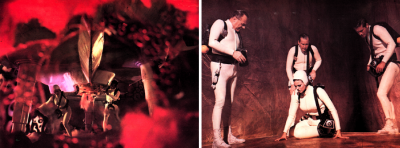 There was an enormous amount of research on Fantastic Voyage – an entire year of pre-production – so it’s as authentic as possible. They had doctors inspect the sets and they’d always know exactly what they were looking at. They even built a model of the heart which, at the time, was the largest working model of a heart ever built, about forty feet wide and thirty feet high and all of it moved! Usually, in a case like this, one would have used miniatures but Richard chose to use giant-scale models, but there were still so many technical problems. For instance, they were shooting three times normal speed in reverse with the camera sometimes upside-down or on its side, and Richard was forced to visualise how it was all going to appear on the screen.
There was an enormous amount of research on Fantastic Voyage – an entire year of pre-production – so it’s as authentic as possible. They had doctors inspect the sets and they’d always know exactly what they were looking at. They even built a model of the heart which, at the time, was the largest working model of a heart ever built, about forty feet wide and thirty feet high and all of it moved! Usually, in a case like this, one would have used miniatures but Richard chose to use giant-scale models, but there were still so many technical problems. For instance, they were shooting three times normal speed in reverse with the camera sometimes upside-down or on its side, and Richard was forced to visualise how it was all going to appear on the screen.
 Despite the basic absurdity of the plot, the film is a visual feast full of memorable images: The submarine Proteus hurtling down a Niagara Falls of liquid through the needle of a hypodermic syringe and into one of the patient’s arteries; The sight of red corpuscles transferring their precious cargoes of oxygen to the cells lining the wall of a blood vessel; The journey through the heart; The interior of the brain itself, which resembles a network of giant spider-webs pulsating with electrical flashes. The art directors on the film were Jack Martin Smith and Dale Hennessey, and the special effects were created by L.B. Abbott, Art Cruikshank and Emil Kosa Junior.
Despite the basic absurdity of the plot, the film is a visual feast full of memorable images: The submarine Proteus hurtling down a Niagara Falls of liquid through the needle of a hypodermic syringe and into one of the patient’s arteries; The sight of red corpuscles transferring their precious cargoes of oxygen to the cells lining the wall of a blood vessel; The journey through the heart; The interior of the brain itself, which resembles a network of giant spider-webs pulsating with electrical flashes. The art directors on the film were Jack Martin Smith and Dale Hennessey, and the special effects were created by L.B. Abbott, Art Cruikshank and Emil Kosa Junior.
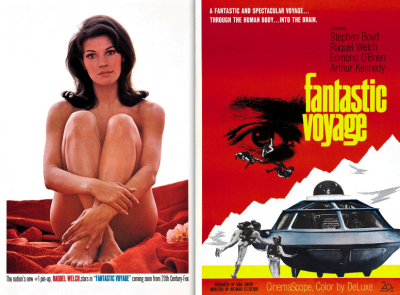 Part of the visual feast that Fantastic Voyage provided was an early glimpse on the screen of Raquel Welch. Clad in a white skin-tight wet-suit, she kept her male colleagues (Stephen Boyd, Donald Pleasance, Arthur Kennedy and William Redfield) aware of the fact that the human body can be a pretty amazing mechanism when seen from the outside as well. And it’s with that thought in mind I’ll ask you to please join me next week when I fish-out more celluloid slop from the wheelie-bin behind Fox Studios, and force-feed it to you without a spoon, all in the name of art for…Horror News! Toodles!
Part of the visual feast that Fantastic Voyage provided was an early glimpse on the screen of Raquel Welch. Clad in a white skin-tight wet-suit, she kept her male colleagues (Stephen Boyd, Donald Pleasance, Arthur Kennedy and William Redfield) aware of the fact that the human body can be a pretty amazing mechanism when seen from the outside as well. And it’s with that thought in mind I’ll ask you to please join me next week when I fish-out more celluloid slop from the wheelie-bin behind Fox Studios, and force-feed it to you without a spoon, all in the name of art for…Horror News! Toodles!
 Horror News | HNN Official Site | Horror Movies,Trailers, Reviews
Horror News | HNN Official Site | Horror Movies,Trailers, Reviews
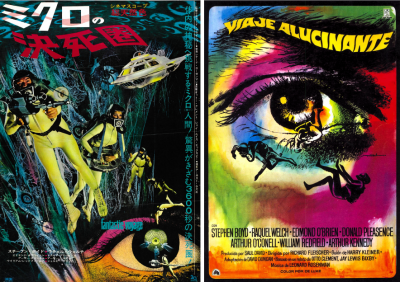
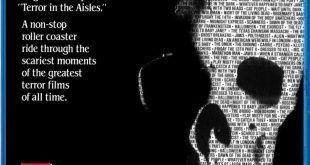



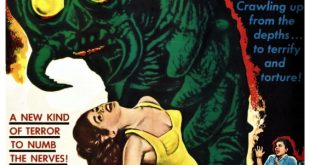

The movie ‘Fantastic Voyage’ still fascinates me. I have seen it way back in 1968 in Bombay, India. I am now residing in London, and have been watching it on DVD at my heart’s content.
Primarily I never failed to watch a Stephen Boyd movie. After his household success as Messala in ‘Ben Hur’, I used to enjoy his movies immensely, and I was besides curiously drawn towards the scientific theme of this movie. It ran to packed houses in India.
Was this movie a box office success in USA? Secondly is this kind of operation such as miniaturising humans and a submarine, and injecting them into the bloodstream of the body possible ? How prescient is this operation in future ?
Hello, good evening and welcome Raja!
Miniaturisation, especially on the scale depicted in Fantastic Voyage, remains a fantastical dream of creators of science fiction like, say, invisibility or time travel. Budgeted at a little more than US$5 million, it made it’s money back pretty easily, particularly after being nominated for five Oscars and winning two. The film received mostly positive reviews and a few criticisms. Variety magazine gave the film a positive pre-release review: “The lavish production, boasting some brilliant special effects and superior creative efforts, is an entertaining, enlightening excursion through inner space – the body of a man.” Bosley Crowther of the New York Times: “Yessir, for straight science-fiction, this is quite a film – the most colorful and imaginative since Destination Moon (1950).” Richard Schickel of Life Magazine wrote that the rewards would be plentiful to audiences who get over the real whopper of suspended disbelief required. He found that though the excellent special effects and sets could distract from the scenery’s scientific purpose in the story, the old familiar music of science fiction in lush new arrangements was a true delight, and the seriousness with which screenwriter Kleiner and director Fleischer treated the story made it more believable and fun. Shickel made note of, but dismissed, other critics’ allegations of ‘camp’.
As of 2010, the film holds a 92% approval rating at the review aggregation website Rotten Tomatoes, with the consensus being: “The special effects may be a bit dated today, but Fantastic Voyage still holds up well as an imaginative journey into the human body.” Thanks again for reading! Please join me next week when I have another opportunity to make your stomach turn and your flesh crawl with another lusting, slashing, ripping flesh-hungry, blood-mad massacre from the back side of Hollywood for…Horror News! Toodles!
Nigel.